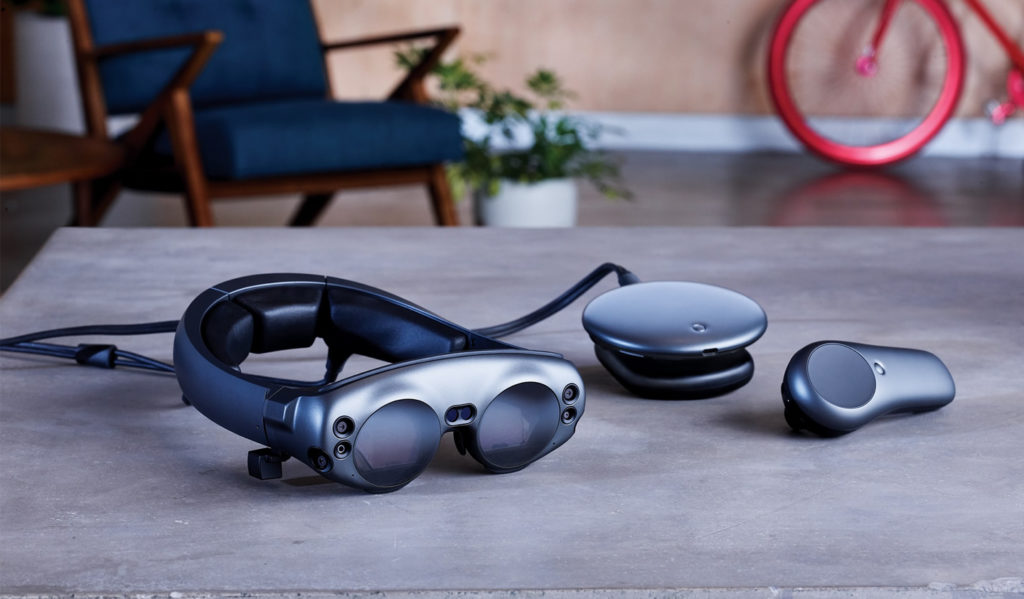The day is finally here and after billions of dollars spent and years of secret development, you can finally buy a Magic Leap mixed reality headset.
The Magic Leap One Creator Edition officially ships in the US today for $2,295.
It’s an interesting piece of technology – the system is packing an Nvidia Parker CPU with two Denver 2.0 64-bit cores and four ARM Cortex A57 64-bit cores. The GPU is an Nvidia Pascal with 256 CUDA cores, and the Lightpack has 8GB of RAM with 128GB of storage capacity and a lithium-ion battery, though a full charge only powers three hours of continuous use.
The whole product consists of three main components. There’s the Lightwear headset, a pair of computerized goggles that drop over your eyes.
The Lightwear is connected to the Lightpack, a puck-shaped computer about the size of a portable CD player, which clips to your pocket.
The Lightpack houses a chip from Nvidia and provides power to the headset. Then there’s a remote that you hold in one hand that allows you to control the experience with a digital pointer that you can see through the glasses.
The company has been talking about changing the way we see and use products for years now, racking up more than $2.3 billion in funding from the likes of Alibaba, Andreesen Horowitz, Google, Warner Bros., and the Kingdom of Saudi Arabia.
The early reviews from tech companies were pretty bad and now that an early version of it is here, it has been getting some pretty good reviews.
For a couple of really good Magic Leap reviews, check out the reviews at CNBC and The Verge.
Also a video review from The Verge below.
Now at over $2200, this is an industrial product which will make more sense for hardcore enthusiasts and businesses.
Magic Leap produces what most people call augmented or mixed reality experiences: hologram-like objects projected into three-dimensional space.
Modern smartphones offer a primitive version of mixed reality, and headsets like Microsoft HoloLens offer a more advanced version for industrial and professional use. Magic Leap has a more ambitious goal: it’s building futuristic mixed reality glasses for everyday computing, hoping to beat bigger companies like Apple or Facebook to market.
My take
Magic Leap is trying to do a REALLY big thing and my gut tells me that they aren’t quite there yet (and may never get there). As someone who was excited about the Playstation VR before I actually used it, I know that this mixed/virtual reality model is not easy to pull off.
I start thinking about the potential uses for the product and some of them are interesting.
- A consumer might be shopping for a car and, with Magic Leap, could see that car right in their driveway and swap out the colors in real time.
- Or a consumer browsing for a pair of shoes online and seeing what the shoes look like in 3-D from their desk.
I think that this is an interesting concept and I see what the company is trying to do but unfortunately I think that based on the reviews I have seen and the amount of money invested there are a few major problems.
First, based on where the company is in the development cycle, I think we are very far away from seeing any must have killer apps for it. The hardware hasn’t been ready so by definition, developers haven’t been ready either.
Second, while I have friends who have seen it and tell me that it’s pretty comfortable, it still looks a little too bulky. It’s a really tough problem to miniaturize hardware for virtual/mixed reality – REALLY hard.
Third, my gut tells me that it’s not technology that a consumer will want to use on a daily basis. It’s the vicious cycle of hardware not being ready, developers not being ready, no killers apps, early release, consumers apathetic.
Fourth, still way too expensive.
Finally, I think that they may be the right product but just at the wrong time. Maybe in a few years, the size of the technology will be as small as a pair of regular glasses and businesses will have the interest and apps for consumers but right now, I just don’t see it.
My own humble take is that unless something can drastically change within 18 months, the real story will be about how much money has been spent here and what investors can do to get their money back.
What do you all think?
